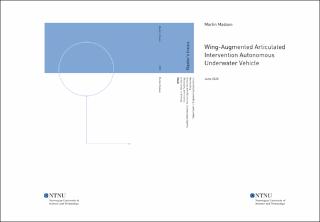| dc.contributor.advisor | Pettersen, Kristin Y. | |
| dc.contributor.author | Martin, Madsen | |
| dc.date.accessioned | 2021-09-23T18:13:11Z | |
| dc.date.available | 2021-09-23T18:13:11Z | |
| dc.date.issued | 2020 | |
| dc.identifier | no.ntnu:inspera:56990118:33260122 | |
| dc.identifier.uri | https://hdl.handle.net/11250/2780962 | |
| dc.description.abstract | Økende temperaturer og forurensing av havet har ført til et økt ønske om å kartlegge havets klima og bærekraftighet. To klasser av undervannsroboter som særlig har utmerket seg for dette formålet i nyere tid er den artikulerte intervensjons-AUV’en og undervannsglidere. Den artikulerte intervensjons-AUV’en (AIAUV) består av en artikulert slank kropp utstyrt med thrustere og kan utføre lette intervensjons-oppdrag. På den annen side har undervannsglideren muligheten til å dekke store distanser takket være sine vinger og effektive ballast-tank. I denne oppgaven vil vi slå sammen disse to robotene ved å utstyre AIAUV’en med vingene fra undervannsglideren.
Formålet med oppgaven er å undersøke om denne nye vinge-utrustede AIAUV’en kan benytte vingene sine for å redusere energiforbruket sitt. Mot dette formålet utvider vi den orginale dynamiske modellen for en AIAUV til å inkludere den hydrodynamiske effekten fra vinger. Vi designer også en skreddersydd kontrollarkitektur for denne nye klassen av undervannsroboter som muligjør følging av veipunkt ved å krumme kroppen sin for å indusere en stampende rotasjon (Eng. pitch).
Med denne nye kontrollarkitekturen gjennomfører vi et simuleringstudie hvor vi sammenligner effektforbruket for en AIAUV med og uten vinge. Resultatene fra disse simuleringene viser at AIAUV’en med vinger trenger markant mindre energi enn den uten vinger siden den med vinger er bedre til å regulere stamp. | |
| dc.description.abstract | With the effect rising global temperatures and pollution have on the worlds oceans monitoring the ocean's health and sustainability is a pressing issue. Two classes of underwater robots that have shown great promise for ocean exploration and surveying in recent years are the Articulated intervention autonomous underwater vehicle and the underwater glider. The Articulated intervention autonomous underwater vehicle (AIAUV) consists of a slender articulated body equipped with thrusters, and can perform light intervention tasks. While the underwater glider is able to travel great distances by gliding through the ocean with wings and an efficient buoyancy-engine. In this thesis we will merge these two robots by equipping the AIAUV with the wings from the glider.
The aim of this thesis is to investigate if this new wing-augmented AIAUV can utilise its wings to reduce its power consumption. To this end we extend the original dynamic model of an AIAUV to include the hydrodynamic effects of wings. We also create a tailored control-architecture for this new class of underwater robot enabling it to track waypoints by curving its body to induce a pitching motion.
With this new control-architecture we perform a simulation study that compares the power consumption for a wing-augmented AIAUV and one without wings. The results from these simulations indicate that the winged AIAUV requires significantly less energy than its unwinged counterpart as the wings enable the AIAUV to better regulate its pitch. | |
| dc.language | | |
| dc.publisher | NTNU | |
| dc.title | Wing-Augmented Articulated Intervention Autonomous Underwater Vehicle | |
| dc.type | Master thesis | |
